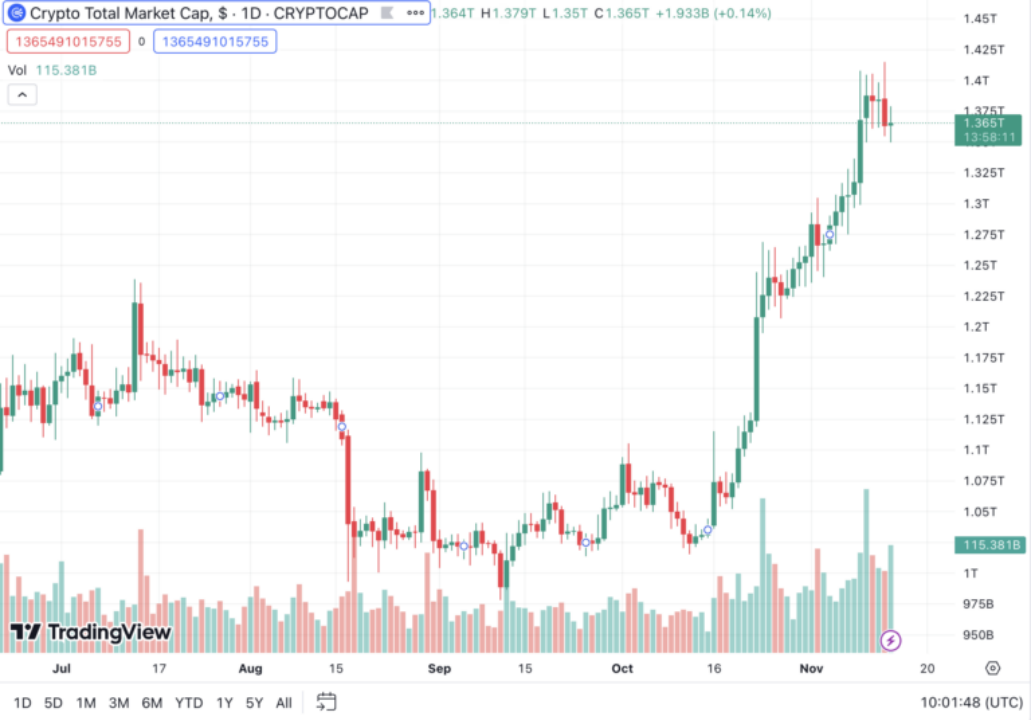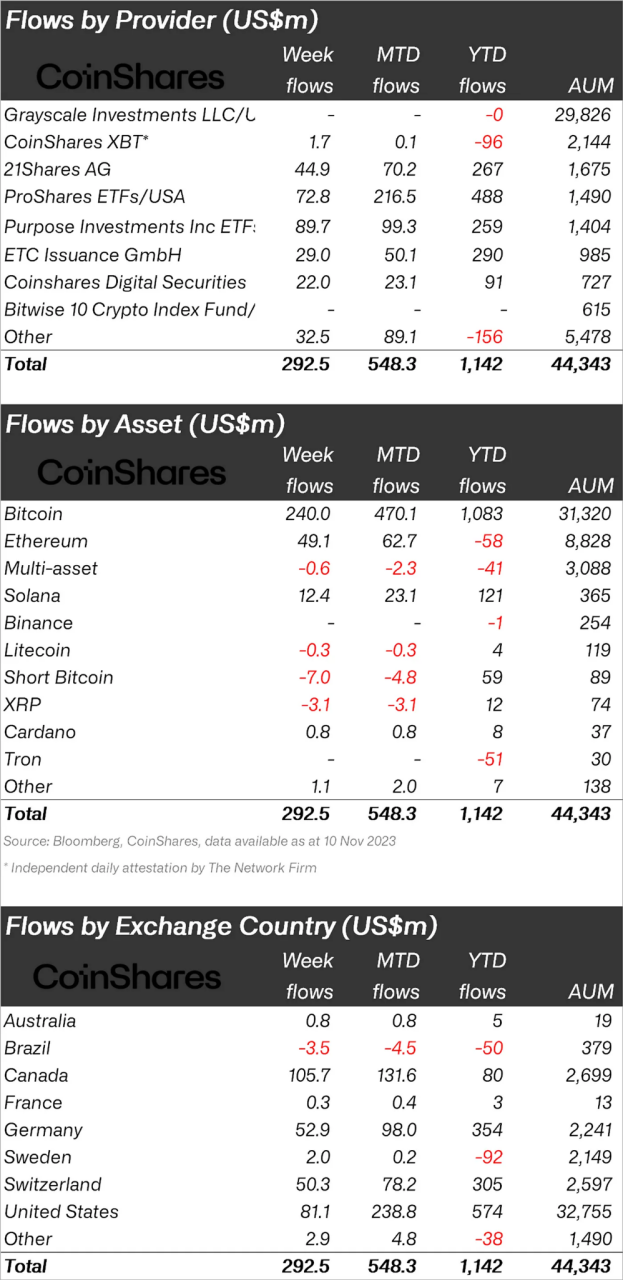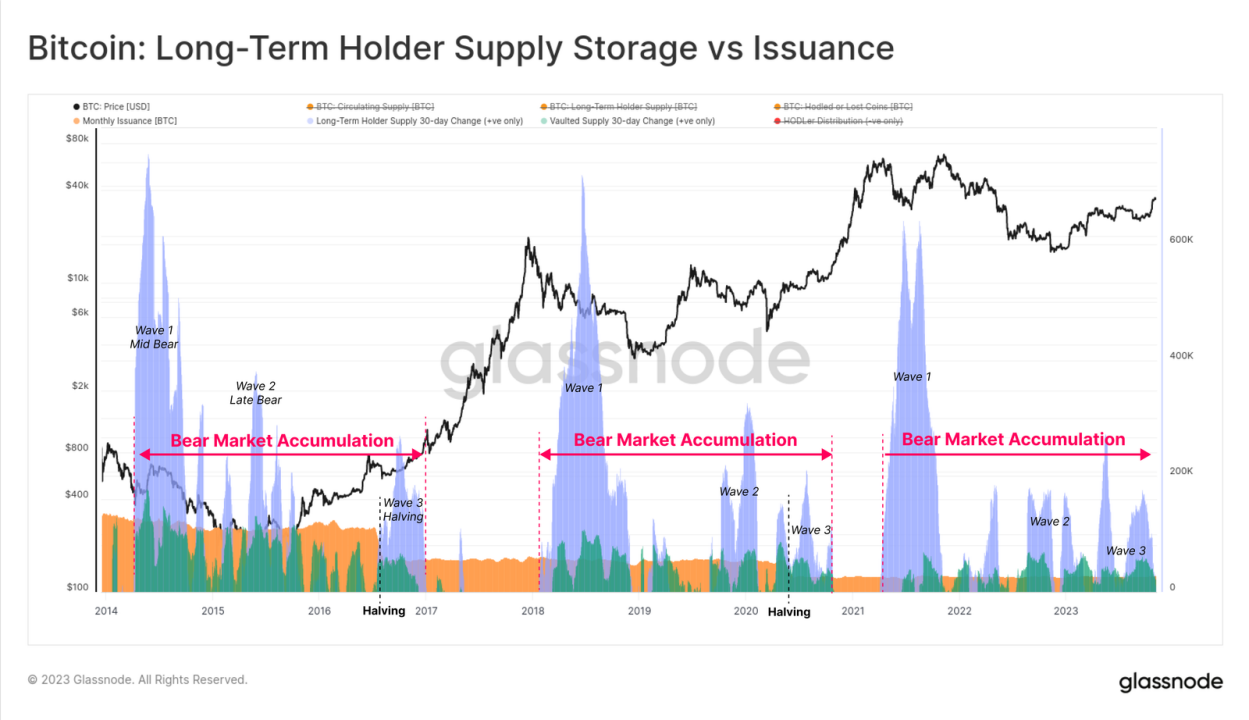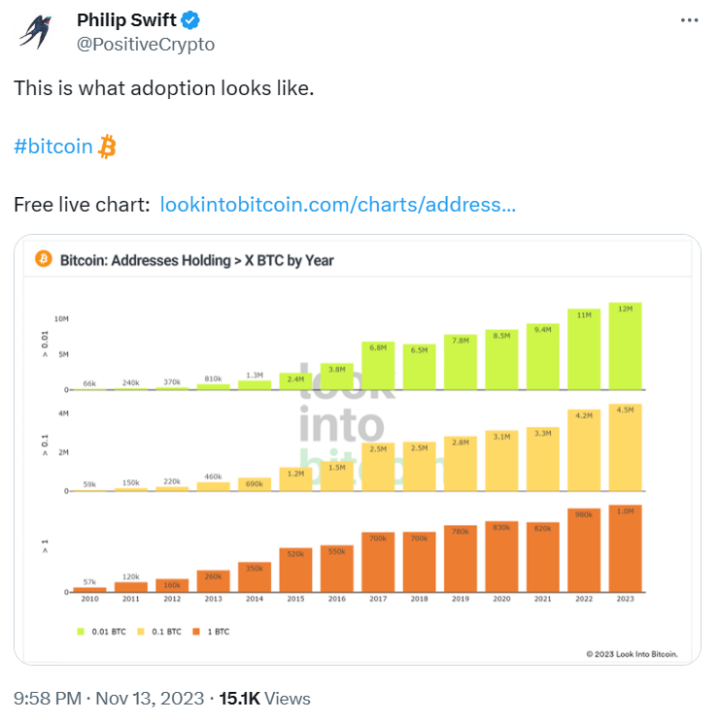$1 billion in institutional funds flows into the crypto market, how will Bitcoin halving affect subsequent investments?
More and more institutional investors are being attracted to Bitcoin, with over $1 billion injected into Bitcoin funds in just two months. This can be seen as a bellwether for the cryptocurrency revival, indicating a promising trajectory for the market in 2023 and beyond. Bitcoin is gradually gaining recognition from institutional investors, viewed as a legitimate asset class with considerable long-term growth potential. Additionally, the combination of Bitcoin's limited supply and the upcoming halving event enhances its appeal, especially for investors seeking scarcity, along with the potential launch of Bitcoin ETFs.
Institutional Investment in Bitcoin Exceeds $1 Billion
CoinShares released its latest weekly report on November 13*, highlighting the narrative of funds flowing back into Bitcoin and altcoins. As excitement builds around the potential approval of the first ETF in the U.S., Bitcoin, Ethereum, and some major altcoins are experiencing price increases.

According to data from TradingView, the total cryptocurrency market capitalization has increased by $600 billion since November 2022. As detailed in the CoinShares report, funding for cryptocurrency investment products has surged over the past two months. The report disclosed: "Last week, the total inflow into digital asset investment products was $293 million, pushing the seven-week inflow to surpass the $1 billion mark. The total inflow for the year to date is $1.14 billion, marking the third-highest annual inflow on record."
A striking statistic highlights the revival of cryptocurrency in 2023: the assets under management (AUM) of cryptocurrency exchange-traded products (ETPs) have nearly doubled since the beginning of the year, with an increase of nearly 10% just last week.
CoinShares emphasized: "Total AUM now stands at $44.3 billion, the highest level since the major cryptocurrency fund collapses in May 2022." The report also revealed that bullish sentiment towards Bitcoin dominated trading volume. It noted, "The total inflow into Bitcoin last week was $240 million, bringing the year-to-date total inflow to $1.08 billion, while short positions on Bitcoin saw an outflow of $7 million, indicating that the market remains bullish."

Bitcoin Scaling to Meet Growing Demand
With the continuous growth of the crypto market, Ordinals have also become exceptionally popular. An earlier article from veDAO Research Institute mentioned the network congestion caused by the surge in Ordinals trading, as interest in BRC-20 tokens has grown, leading to rising Bitcoin transaction fees. After weeks of accumulation, the average transaction fee skyrocketed since the end of October, peaking at over $16 on November 9, the highest in six months. Fortunately, the evolving ecosystem of Bitcoin sidechains and scaling protocols is expected to simplify Ordinals transactions and bring fees back to more manageable levels.
In the 14 years since Bitcoin's inception, the volume of transaction data has surged, and the emergence of Ordinals is just the latest trend putting pressure on the blockchain's limited throughput. As researchers began focusing on Bitcoin's scalability challenges in the mid-2010s, the initial emphasis was on enabling faster and cheaper transactions. For example, the Lightning Network, launched in 2019 as a dedicated Layer 2 network, aims to support peer-to-peer Bitcoin micropayments.
In the context of Ordinals, connecting BRC-20 tokens to more efficient sidechains can significantly reduce fees and create a smoother trading environment. For instance, Bioniq uses the Internet Computer Protocol (ICP) to encapsulate Ordinals, allowing users to trade without incurring transaction fees. Similarly, Bitmos, a dedicated blockchain network built on Cosmos, aims to enhance the scalability of Ordinals projects. The platform is set to launch next year, with cross-chain bridges enabling users to create BRC-20 tokens that can move freely between Cosmos chains.
As Ordinals evolve, bridging and scaling solutions may support new and more complex use cases for Bitcoin-based assets. This will also reflect on Bitcoin's supply dynamics.
Reevaluating Bitcoin's Supply Dynamics
To address the growing interest, on-chain analytics firm Glassnode has conducted an in-depth study to reevaluate Bitcoin's supply dynamics. According to Glassnode's latest weekly report, "The Week On-Chain**", there are only five months left until the next block halving, and the amount of Bitcoin held in storage has now exceeded 2.4 times the amount mined. The upcoming fourth halving event holds significant fundamental and technical implications for Bitcoin. Glassnode noted that considering the substantial returns in previous cycles, this is an extremely attractive event for investors.

The weekly report includes several charts, with the above showing the Bitcoin supply held by long-term holders (LTH), defined as entities holding tokens for 155 days or longer. Philip Swift, founder of the statistical platform Look Into Bitcoin, emphasized that the presence of wallet entities is continuously increasing, tweeting on the 13th, "This is what adoption looks like."

How Will the Halving Affect Investments in 2024?
The next Bitcoin halving event is set to occur in April 2024, during which the number of Bitcoins awarded to miners will be halved. This event is expected to further reduce the supply of Bitcoin, potentially making the asset more attractive to investors.
In previous Bitcoin halving events, we have observed some meaningful trends. First, after each halving, Bitcoin's price typically experiences a period of increase. Whether this trend will continue into the next halving remains to be seen. Historically, Bitcoin's halving events have intensified market scarcity, leading to upward price pressure, which explains the bull markets that follow each halving.
After experiencing the crypto winter of 2022 and the economic downturn of 2023, the timing of Bitcoin's halving in 2024 is crucial. By slowing the rate of Bitcoin creation, it will limit the supply of Bitcoin over time, applying gold-like scarcity to it. Bitcoin's halving promotes innovation and resilience in its native cryptocurrency, distinguishing it from fiat currencies. The 2024 Bitcoin halving will affect the rate at which new Bitcoins enter the market. This event will reduce the reward from 6.25 BTC to 3.125 BTC, and to maintain profitability, miners must find ways to optimize their operations as rewards decrease. This may encourage miners to improve efficiency.
Additionally, we can view this issue from a longer timeline. In Bitcoin's early stages, its price was relatively low and highly volatile. However, over time and with the gradual adoption of Bitcoin, its price began to rise steadily. This means that while halving events may have some impact on Bitcoin's price, the long-term trend may depend more on other factors such as market supply and demand, macroeconomic conditions, and the development of the Bitcoin ecosystem.
Conclusion
Overall, the increase in institutional interest in Bitcoin is a positive signal for the crypto industry, indicating that institutional investors are increasingly accepting Bitcoin and viewing it as a legitimate asset class. The next halving event may also have a positive impact on Bitcoin's price, attracting more investors to the asset.
References:
https://insights.glassnode.com/the-week-onchain-week-46-2023/
Follow Us
veDAO is an AI-driven web3 trend tracking & smart trading one-stop platform that combines market trends presented by big data analysis with trading depth, dedicated to creating a web3 AI exchange that is more suitable for Web2 and Web3 users to buy and sell investments.
veDAO has an industry-leading AI large language model composed of on-chain analysis & sentiment indicators, providing users with proactive data support, combined with intelligent, fast, secure, and real-time monitoring AI trading features. As of now, the platform has over 40,000 heavy users, is connected with over 22,000 Web3 vertical industry Twitter KOLs, and has formed the veDAO Expert Committee with over 180 professional institutions. The platform's project library exceeds 10,000 projects, and there are over 240 scouts continuously increasing Web3 projects alongside veDAO.
veDAO is continuously upgrading at a pace of bi-weekly version updates, determined to build a bridge from Web2 to Web3, becoming the preferred platform for future Web2 and Web3 users to check projects, find hotspots, observe trends, engage in primary investments, and conduct secondary trading.
Website: http://www.vedao.com/
Twitter: https://twitter.com/vedao_official
Facebook: bit.ly/3jmSJwN
Telegram: t.me/veDAO_zh
Discord: https://discord.gg/NEmEyrWfjV
Investing involves risks; projects are for reference only, and risks are to be borne by yourself.










